Content is from Kirkbride et al. 2006Kirkbride et al. 2006:
Kirkbride JH, Jr, Gunn CR, and Dallwitz MJ. 2006. Family guide for fruits and seeds, vers. 1.0. Accessed September 2020-January 2022. URL: https://nt.ars-grin.gov/seedsfruits/keys/frsdfam/index.cfm ., without modification.
Updates are forthcoming.
Fruits: Pistil(s) compound; 1; 1-pistillate; with carpels united. Fruit pericarpium; simple; capsulecapsule:
a dry, dehiscent fruit derived from a compound ovary ; polospermatium capsulecapsule:
; polospermatium capsulecapsule:
a dry, dehiscent fruit derived from a compound ovary (Spjut listed 2 families: Euphorbiaceae & Ctenolophonaceae as Hugoniaceae); capsulecapsule:
(Spjut listed 2 families: Euphorbiaceae & Ctenolophonaceae as Hugoniaceae); capsulecapsule:
a dry, dehiscent fruit derived from a compound ovary not inflated; capsulecapsule:
not inflated; capsulecapsule:
a dry, dehiscent fruit derived from a compound ovary without operculumoperculum:
without operculumoperculum:
a dehiscent cap (or lid) of a seed or fruit that opens during germination or dehiscence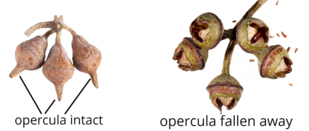 ; with persistent central column; but filiform; valves diverging from top of central column (resembling umbrella ribs); not within accessory organ(s); 1-seeded; 1-seeded; 1.3–2.4 cm long; with 2-carpellate, or 1-carpellate; without sterilesterile:
; with persistent central column; but filiform; valves diverging from top of central column (resembling umbrella ribs); not within accessory organ(s); 1-seeded; 1-seeded; 1.3–2.4 cm long; with 2-carpellate, or 1-carpellate; without sterilesterile:
lacking male and/or female reproductive parts; also, not producing fruit or seed
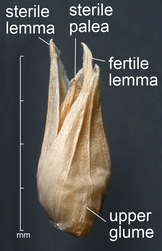 carpels; apexapex:
carpels; apexapex:
the point farthest from the point of attachment, or the "tip" of an organ not beaked; wall woodywoody:
not beaked; wall woodywoody:
texture—consisting mainly of indurate lignified tissues, characteristic of or resembling wood
; dehiscentdehiscent:
(v. dehisce) splitting open at maturity to release contents (of a fruit)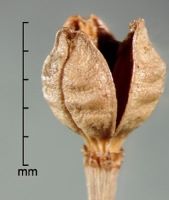 . Dehiscentdehiscent:
. Dehiscentdehiscent:
(v. dehisce) splitting open at maturity to release contents (of a fruit) unit seed(s). Dehiscentdehiscent:
unit seed(s). Dehiscentdehiscent:
(v. dehisce) splitting open at maturity to release contents (of a fruit) and shedding seeds; without replumreplum:
and shedding seeds; without replumreplum:
the rim, formed by the persistent placentas, and connected by a false septum in Brassicaceae fruits. The fruit valves are attached to this rim and separate from it in dehiscent fruits.
. Epicarpepicarp:
outer layer of fruit wall or pericarp, if divided into layers; note here used synonymously with exocarp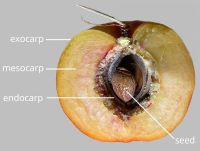 brown (all shades); shinyshiny:
brown (all shades); shinyshiny:
uniformly reflecting a high proportion of incident light at all angles ; durable; not glabrousglabrous:
; durable; not glabrousglabrous:
without hairs
(with hairs); hairs dense (tufted hairs); hairs not glandularglandular:
surface relief—covered with small, raised secretory glands, regular or irregularly shaped, translucent or opaque, and maybe distinctly colored ; without armature; not smooth; ribbedribbed:
; without armature; not smooth; ribbedribbed:
surface relief—wide, prominent, linear ridges that are generally rounded and longitudinally situated on the surface ; without wing(s); without apicalapical:
; without wing(s); without apicalapical:
at or pertaining to the end of the seed or fruit distal from its point of attachment (i.e., base)
respiratory hole. Endocarpendocarp:
the inner layer of the pericarp, if divided into layers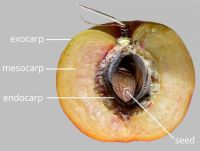 present; not separating from exocarpexocarp:
present; not separating from exocarpexocarp:
outer layer of fruit wall or pericarp, if divided into layers; note here used synonymously with epicarp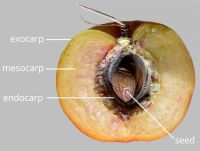 ; thin; not splitting into 1-seeded pyrenes; smooth; without wing; without operculumoperculum:
; thin; not splitting into 1-seeded pyrenes; smooth; without wing; without operculumoperculum:
a dehiscent cap (or lid) of a seed or fruit that opens during germination or dehiscence ; without secretory cavities; without mechanism for seedling escape; without grooves; without longitudinallongitudinal:
; without secretory cavities; without mechanism for seedling escape; without grooves; without longitudinallongitudinal:
of or relating to length or the lengthwise dimension
ridges. Funiculusfuniculus:
(alt. funicle) stalk connecting the ovule (later seed) to the ovary (later fruit) placenta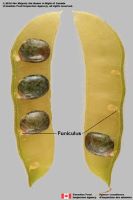 short; short without seed bearing hookswith hooks:
short; short without seed bearing hookswith hooks:
bristles or spines with curved or backwards pointing tips, or with secondary bristles along their length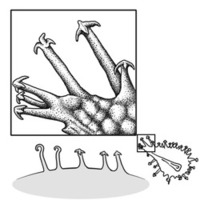 (retinacula); not persisting in fruit after seed shed.
(retinacula); not persisting in fruit after seed shed.
Seeds: Arilaril:
(broad sense) appendicular structure that wholly or partly envelops a seed and is produced from or a modification of the funicle, raphe, or outer integument; usually fleshy or pulpy, sometimes spongy or tufted-capillate, often brightly colored present; a true arilaril:
present; a true arilaril:
(broad sense) appendicular structure that wholly or partly envelops a seed and is produced from or a modification of the funicle, raphe, or outer integument; usually fleshy or pulpy, sometimes spongy or tufted-capillate, often brightly colored ; orange, or red (brilliant), or white; well developed; adnate to hilumhilum:
; orange, or red (brilliant), or white; well developed; adnate to hilumhilum:
on seeds, the scar indicating where the funiculus was attached; on grass caryopses, the scar visible on the outer fruit surface revealing where the seed is attached on the inner fruit wall surface; or in Asteraceae cypselae, the scar visible on the outer fruit wall revealing where the fruit was attached to the receptacle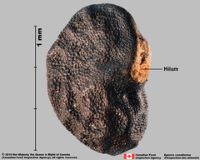 ; fleshy; of funicularfuniculus:
; fleshy; of funicularfuniculus:
(alt. funicle) stalk connecting the ovule (later seed) to the ovary (later fruit) placenta origin; basalbasal:
origin; basalbasal:
at or pertaining to the point of attachment; (of embryo) embryo occupies one end of the seed
(up to lower half); does not aid in seed explusion from fruit; fibrousfibrous:
texture—long, flexible threads, thicker than hairs, that densely cover and obscure the surface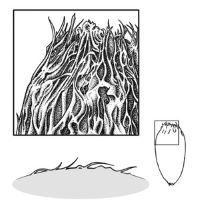 , or fleshy; hairy-papillose which are red when dry surrounded by a gelinous transparent layer. Seed larger than minute; 1 to less than 5 mm long to 5 to less than 10 mm long; 4–7 mm long; ellipsoidellipsoid:
, or fleshy; hairy-papillose which are red when dry surrounded by a gelinous transparent layer. Seed larger than minute; 1 to less than 5 mm long to 5 to less than 10 mm long; 4–7 mm long; ellipsoidellipsoid:
3D shape—elliptic
, or obovoidobovoid:
3D shape—obovate
, or straight; not bowl shaped; not nutlike; without winglike beakbeak:
a usually firm, terminal appendage, sometimes tapered ; without caudatecaudate:
; without caudatecaudate:
tapering to a long, tail-like appendage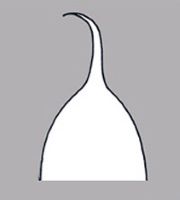 appendage(s); at maturity with food reserves, or without food reserves; with endosperm; without canavanine. Sarcotestasarcotesta:
appendage(s); at maturity with food reserves, or without food reserves; with endosperm; without canavanine. Sarcotestasarcotesta:
pulpy or fleshy outer layer of the seed coat, simulates aril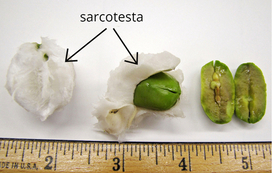 absent. Testatesta:
absent. Testatesta:
seed coat
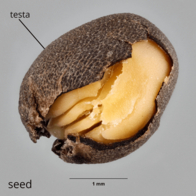 present; without fleshy or leatheryleathery:
present; without fleshy or leatheryleathery:
texture—moderately thick, tough, and very pliable
layer over hard layer; tight; surface smooth, or unsmooth; surface with depressed features; surface groovedgrooved:
surface relief—linear depressions that may be single or form a series of grooves over the surface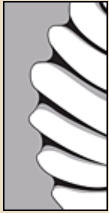 ; without crease or line separating cotyledons from hypocotyl-radicle; without notch along margin where cotyledons from hypocotyl-radicle tip approach each other; without glands; without bristles; glabrousglabrous:
; without crease or line separating cotyledons from hypocotyl-radicle; without notch along margin where cotyledons from hypocotyl-radicle tip approach each other; without glands; without bristles; glabrousglabrous:
without hairs
; without wings; without collar; without operculumoperculum:
a dehiscent cap (or lid) of a seed or fruit that opens during germination or dehiscence ; colored; monochrome; red (olive-), or brown (all shades) (purplish-); crustaceouscrustaceous:
; colored; monochrome; red (olive-), or brown (all shades) (purplish-); crustaceouscrustaceous:
texture—thin, dry, indurate, and brittle
; not becoming mucilaginousmucilaginous:
resembling mucilage; moist and sticky
when wetted; surrounding food reserve. Hilumhilum:
on seeds, the scar indicating where the funiculus was attached; on grass caryopses, the scar visible on the outer fruit surface revealing where the seed is attached on the inner fruit wall surface; or in Asteraceae cypselae, the scar visible on the outer fruit wall revealing where the fruit was attached to the receptacle apicalapical:
apicalapical:
at or pertaining to the end of the seed or fruit distal from its point of attachment (i.e., base)
. Endosperm copious; fleshy and soft (spongyspongy:
soft, light, discontinuous but cohesive, and somewhat resilient
); without fatty acid containing cyclopropene; without apicalapical:
at or pertaining to the end of the seed or fruit distal from its point of attachment (i.e., base)
lobes; without chlorophyll; without isodiametric faceted surface; without odor. Embryo differentiated from food reserve; well developed; 1 per seed; nearly filling testatesta:
seed coat
 (trace or scanty food reserve); at one end of seed not extending into a depression or cup; foliatefoliate:
(trace or scanty food reserve); at one end of seed not extending into a depression or cup; foliatefoliate:
appearing leaf-like
; with investinginvesting:
(of embryo) embryo is nearly or completely filling seed coat, straight, and axile and centric with spatulate cotyledons and covering the stalk for at least half its length; (of cotyledons) cotyledons spatulate and covering the stalk for at least half its length
cotyledons (more or less); straight; with cotyledons abruptly connected to hypocotyl-radicle; without coleorhiza; without simmondsin; without stomata; not green; with 2 or more cotyledons. Cotyledons 2; well developed; 0.8 times length of embryo; somewhat to significantly wider than hypocotyl-radicle; 3 times wider than hypocotyl-radicle; equal in size; not punctatepunctate:
surface relief—dotted with pits or with translucent, sunken glands or with colored dots, similar to pitted dotted.
dotted.
 , surrounding lower half of the seed". This paper has excellent seed & fruit drawings.
, surrounding lower half of the seed". This paper has excellent seed & fruit drawings.
Literature specific to this family: Badré, F. 1972b. Malpighiacées, Linacées, Lépidobotrtacées, Cténolophonacées, Húmiriacées, Erythroxylacées, Ixonanthacées. In: A. Aubréville & J.-F. Leroy, eds., Flore du Cameroun, vol. 14, pp. 3–63. Muséum National d'Histoire Naturelle, Paris; Keay, R.W.J., C.F.A. Onochie, & D.P. Stanfield. 1989. Trees of Nigeria, ed. 2. Clarendon Press, Oxford.
General references: Cronquist, A. 1981. An integrated system of classification of flowering plants, 1,262 p. Columbia University Press, New York, Engler, A. 1900–1953. Das Pflanzenreich, nos. 1–107. Facsimile edition. Engelmann-Cramer, Weinheim, Goldberg, A. 1986 (dicots) & 1989 (monocots). Classification, evolution, and phylogeny of the familes of Dicotyledons. Smithsonian Contr. Bot. 58 for dicots (314 pp.) & 71 for monocots (74 pp.). [Goldberg's illustrations are reproduced from older publications and these should be consulted], Gunn, C.R., J.H. Wiersema, C.A. Ritchie, & J.H. Kirkbride, Jr. 1992 & amendments. Families and genera of Spermatophytes recognized by the Agricultural Research Service. Techn. Bull. U.S.D.A. 1796:1–500, Mabberley, D.J. 1987. The plant-book, 706 p. Cambridge University Press, Cambridge, Spjut, R.W. 1994. A systematic treatment of fruit types. Mem. New York Bot. Gard. 70:1–182, and Steenis, C.G.G.J. van, ed. 1950 onwards. Flora Malesiana, ser. 1. Spermatophyta. Noordhoff-Kolff, Djakarta.